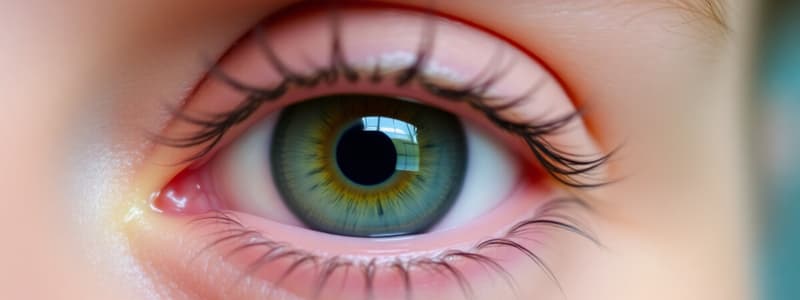Podcast
Questions and Answers
When should surgical intervention for ptosis be performed to prevent amblyopia?
When should surgical intervention for ptosis be performed to prevent amblyopia?
- If the pupil area is covered and ptosis is severe (correct)
- If ptosis is noted at an early age
- If ptosis is moderate without pupil involvement
- If ptosis is mild and vision is unaffected
What type of surgical operation is indicated for mild ptosis due to Muller muscle weakness?
What type of surgical operation is indicated for mild ptosis due to Muller muscle weakness?
- Frontalis muscle sling
- Fasanella Servat operation (correct)
- Levator resection operation
- Sling operation
Which surgical approach is used in the Levator resection operation?
Which surgical approach is used in the Levator resection operation?
- Skin and conjunctival approach (correct)
- Skin approach only
- Conjunctival approach only
- Frontalis muscle sling approach
What condition necessitates the use of Sling operations for ptosis?
What condition necessitates the use of Sling operations for ptosis?
Which option describes the primary goal for postponing surgery in mild and moderate ptosis?
Which option describes the primary goal for postponing surgery in mild and moderate ptosis?
What characterizes ptosis in terms of eyelid position?
What characterizes ptosis in terms of eyelid position?
Which of the following is NOT a form of acquired ptosis?
Which of the following is NOT a form of acquired ptosis?
What is the marginal reflex distance (MRD) used to measure in cases of ptosis?
What is the marginal reflex distance (MRD) used to measure in cases of ptosis?
Which condition is characterized by the elevation of the ptosed lid with jaw movement?
Which condition is characterized by the elevation of the ptosed lid with jaw movement?
In assessing levator function, what result indicates good function?
In assessing levator function, what result indicates good function?
Which of the following could be a contraindication for surgical treatment of ptosis?
Which of the following could be a contraindication for surgical treatment of ptosis?
Which condition can contribute to mechanical ptosis?
Which condition can contribute to mechanical ptosis?
What should be excluded during the evaluation of ptosis before making a diagnosis?
What should be excluded during the evaluation of ptosis before making a diagnosis?
Flashcards are hidden until you start studying
Study Notes
Ptosis
- Definition: Drooping of the upper eyelid that covers more than the upper 1/6 (or 2 mm) of the cornea.
- Causes:
- Congenital: Present at birth.
- Acquired: Develops later in life.
- Neurogenic: Nerve problems affecting the eyelid muscles. - Oculomotor nerve palsy: Paralysis of the levator muscle. - Sympathetic paralysis: Paralysis of Muller's muscle.
- Myogenic: Muscle problems affecting the eyelids. - Myasthenia gravis: Autoimmune disease causing muscle weakness. - Muscle dystrophy: Genetic disorder causing muscle degeneration.
- Apponeurotic: Problems with the tissue that connects the eyelid to the eye socket. - Involutional ptosis: Age-related weakening of the eyelid muscles. - Post-operative ptosis: Drooping after eyelid surgery.
- Traumatic: Injury causing eyelid drooping. - Mechanical: Weight of a chalazion (cyst) or tumor on the eyelid. - Hysterical ptosis: Rare form of ptosis associated with psychological factors.
- Examination:
- History: Age of onset, history of fever, trauma, and family history.
- Exclude pseudoptosis: Drooping due to other causes, such as:
- Microphthalmos: An abnormally small eye.
- Enophthalmos: An eye that is sunken into the socket.
- Contralateral lid retraction: The other eyelid is pulled upward.
- Measurements:
- Marginal reflex distance (MRD): The distance between the eyelid margin and the corneal light reflex, estimating ptosis severity.
- Levator function: How much the eyelid can move, measured in millimeters.
- Good: 12 mm.
- Fair: 6-11 mm.
- Poor: 5 mm or less.
- Associated signs:
- Jaw-winking (Marcus Gunn’s phenomenon): The drooping eyelid rises when the jaw moves.
- Superior rectus weakness: Weakness of the muscle that moves the eye upward.
- Epicanthus: A fold of skin covering the inner corner of the eye.
- Surgical treatment of Ptosis:
- Indications:
- Congenital ptosis: Present at birth.
- Acquired ptosis: When the cause cannot be treated or treatment has failed.
- Contraindications:
- Complete third nerve paralysis with diplopia: Double vision due to paralysis of the third cranial nerve.
- Corneal anesthesia or absence of Bell’s phenomenon: Lack of corneal sensitivity or inability to close the eyelids when the eyes are closed.
- Time of surgery:
- Severe ptosis: Surgery as early as possible to avoid amblyopia (lazy eye) if the pupil is covered.
- Mild-moderate ptosis: Surgery delayed until preschool age (5 years) if the vision is not affected.
- Types of surgery:
- Fasanella Servat operation: For mild ptosis due to weak Muller muscle. Resects the Muller muscle through a conjunctival approach.
- Levator resection operation: For mild to moderate ptosis due to weak levator muscle.
- Skin approach: Everbusch’s operation.
- Conjunctival approach: Blascovics operation.
- Sling operations: For severe ptosis when the levator muscle is paralyzed. Lifts the eyelid using:
- Fascia lata: Tissue from the thigh.
- Mersaline mesh: Synthetic material.
- Frontalis muscle sling: Uses muscles in the forehead.
- Indications:
Studying That Suits You
Use AI to generate personalized quizzes and flashcards to suit your learning preferences.




